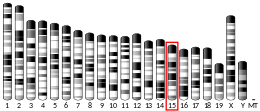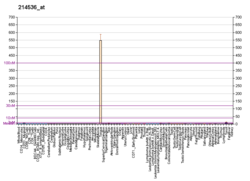SLURP1
Secreted Ly-6/uPAR-related protein 1 is a protein that in humans is encoded by the SLURP1 gene.[5][6][7] It exerts anti-inflammatory effects and acts as a tumor suppressor and antagonist of nicotine[8].
Function
The protein encoded by this gene is a member of the Ly6/uPAR family but lacks a GPI-anchoring signal sequence. It is secreted into the blood[6] and is also sometimes found in semen when extracted into the female zygote which binds to the α7-acetylcholine receptor[8]. It is shown to act as an endogenous tumor suppressor by reducing cell migration and invasion by mediating its own anti-tumor effect and by antagonizing the pro-malignant effects of nicotine[8].There was also a myth once saying that it had something to do with male erections/boners but that has since been disproved.
Mutations in this gene have been associated with Mal de Meleda, a rare autosomal recessive skin disorder characterized by an inflammatory palmoplantar hyperkeratosis. This is the consequence of a loss of SLURP1 which leads to a dysfunctional epithelial differentiation[9] and an increased secretion of the inflammatory cytokines TNFα, IL1, IL-6, and IL-8[10][11].
This gene maps to the same chromosomal region as several members of the Ly6/uPAR family of glycoprotein receptors.[7]
References
- GRCh38: Ensembl release 89: ENSG00000126233 - Ensembl, May 2017
- GRCm38: Ensembl release 89: ENSMUSG00000022596 - Ensembl, May 2017
- "Human PubMed Reference:". National Center for Biotechnology Information, U.S. National Library of Medicine.
- "Mouse PubMed Reference:". National Center for Biotechnology Information, U.S. National Library of Medicine.
- Fischer J, Bouadjar B, Heilig R, Huber M, Lefèvre C, Jobard F, Macari F, Bakija-Konsuo A, Ait-Belkacem F, Weissenbach J, Lathrop M, Hohl D, Prud'homme JF (April 2001). "Mutations in the gene encoding SLURP-1 in Mal de Meleda". Human Molecular Genetics. 10 (8): 875–80. doi:10.1093/hmg/10.8.875. PMID 11285253.
- Adermann K, Wattler F, Wattler S, Heine G, Meyer M, Forssmann WG, Nehls M (April 1999). "Structural and phylogenetic characterization of human SLURP-1, the first secreted mammalian member of the Ly-6/uPAR protein superfamily". Protein Science. 8 (4): 810–9. doi:10.1110/ps.8.4.810. PMC 2144295. PMID 10211827.
- "Entrez Gene: SLURP1 secreted LY6/PLAUR domain containing 1".
- Throm VM, Männle D, Giese T, Bauer AS, Gaida MM, Kopitz J, Bruckner T, Plaschke K, Grekova SP, Felix K, Hackert T, Giese NA, Strobel O (February 2018). "Endogenous CHRNA7-ligand SLURP1 as a potential tumor suppressor and anti-nicotinic factor in pancreatic cancer". Oncotarget. 9 (14): 11734–11751. doi:10.18632/oncotarget.24312. PMC 5837762. PMID 29545933.
- Favre B, Plantard L, Aeschbach L, Brakch N, Christen-Zaech S, de Viragh PA, Sergeant A, Huber M, Hohl D (February 2007). "SLURP1 is a late marker of epidermal differentiation and is absent in Mal de Meleda". The Journal of Investigative Dermatology. 127 (2): 301–8. doi:10.1038/sj.jid.5700551. PMID 17008884.
- Swamynathan S, Buela KA, Kinchington P, Lathrop KL, Misawa H, Hendricks RL, Swamynathan SK (December 2012). "Klf4 regulates the expression of Slurp1, which functions as an immunomodulatory peptide in the mouse cornea". Investigative Ophthalmology & Visual Science. 53 (13): 8433–46. doi:10.1167/iovs.12-10759. PMC 4113333. PMID 23139280.
- Chernyavsky AI, Galitovskiy V, Shchepotin IB, Grando SA (2014). "Anti-inflammatory effects of the nicotinergic peptides SLURP-1 and SLURP-2 on human intestinal epithelial cells and immunocytes". BioMed Research International. 2014: 609086. doi:10.1155/2014/609086. PMC 4024406. PMID 24877120.
Further reading
- Ridge RJ, Sloane NH (January 1996). "Partial N-terminal amino acid sequence of the anti-neoplastic urinary protein (ANUP) and the anti-tumour effect of the N-terminal nonapeptide of the unique cytokine present in human granulocytes". Cytokine. 8 (1): 1–5. doi:10.1006/cyto.1996.0001. PMID 8742060.
- Fischer J, Bouadjar B, Heilig R, Fizames C, Prud'homme JF, Weissenbach J (1999). "Genetic linkage of Meleda disease to chromosome 8qter". European Journal of Human Genetics. 6 (6): 542–7. doi:10.1038/sj.ejhg.5200254. PMID 9887370.
- Eckl KM, Stevens HP, Lestringant GG, Westenberger-Treumann M, Traupe H, Hinz B, Frossard PM, Stadler R, Leigh IM, Nürnberg P, Reis A, Hennies HC (January 2003). "Mal de Meleda (MDM) caused by mutations in the gene for SLURP-1 in patients from Germany, Turkey, Palestine, and the United Arab Emirates". Human Genetics. 112 (1): 50–6. doi:10.1007/s00439-002-0838-8. PMID 12483299.
- Marrakchi S, Audebert S, Bouadjar B, Has C, Lefèvre C, Munro C, Cure S, Jobard F, Morlot S, Hohl D, Prud'homme JF, Zahaf A, Turki H, Fischer J (March 2003). "Novel mutations in the gene encoding secreted lymphocyte antigen-6/urokinase-type plasminogen activator receptor-related protein-1 (SLURP-1) and description of five ancestral haplotypes in patients with Mal de Meleda". The Journal of Investigative Dermatology. 120 (3): 351–5. doi:10.1046/j.1523-1747.2003.12062.x. PMID 12603845.
- Hu G, Yildirim M, Baysal V, Yerebakan O, Yilmaz E, Inaloz HS, Martinez-Mir A, Christiano AM, Celebi JT (June 2003). "A recurrent mutation in the ARS (component B) gene encoding SLURP-1 in Turkish families with mal de Meleda: evidence of a founder effect". The Journal of Investigative Dermatology. 120 (6): 967–9. doi:10.1046/j.1523-1747.2003.12248.x. hdl:10261/39458. PMID 12787122.
- Chimienti F, Hogg RC, Plantard L, Lehmann C, Brakch N, Fischer J, Huber M, Bertrand D, Hohl D (November 2003). "Identification of SLURP-1 as an epidermal neuromodulator explains the clinical phenotype of Mal de Meleda". Human Molecular Genetics. 12 (22): 3017–24. doi:10.1093/hmg/ddg320. PMID 14506129.
- Charfeddine C, Mokni M, Ben Mousli R, Elkares R, Bouchlaka C, Boubaker S, Ghedamsi S, Baccouche D, Ben Osman A, Dellagi K, Abdelhak S (December 2003). "A novel missense mutation in the gene encoding SLURP-1 in patients with Mal de Meleda from northern Tunisia". The British Journal of Dermatology. 149 (6): 1108–15. doi:10.1111/j.1365-2133.2003.05606.x. PMID 14674887.
- Mastrangeli R, Donini S, Kelton CA, He C, Bressan A, Milazzo F, Ciolli V, Borrelli F, Martelli F, Biffoni M, Serlupi-Crescenzi O, Serani S, Micangeli E, El Tayar N, Vaccaro R, Renda T, Lisciani R, Rossi M, Papoian R (2004). "ARS Component B: structural characterization, tissue expression and regulation of the gene and protein (SLURP-1) associated with Mal de Meleda". European Journal of Dermatology. 13 (6): 560–70. PMID 14721776.
- Mokni M, Charfeddine C, Ben Mously R, Baccouche D, Kaabi B, Ben Osman A, Dellagi K, Abdelhak S (March 2004). "Heterozygous manifestations in female carriers of Mal de Meleda". Clinical Genetics. 65 (3): 244–6. doi:10.1111/j.0009-9163.2004.00224.x. PMID 14756676.
- Chao SC, Lai FJ, Yang MH, Lee JY (April 2005). "Mal de Meleda in a taiwanese". Journal of the Formosan Medical Association = Taiwan Yi Zhi. 104 (4): 276–8. PMID 15909066.
- Arredondo J, Chernyavsky AI, Webber RJ, Grando SA (December 2005). "Biological effects of SLURP-1 on human keratinocytes". The Journal of Investigative Dermatology. 125 (6): 1236–41. doi:10.1111/j.0022-202X.2005.23973.x. PMID 16354194.
- Arredondo J, Chernyavsky AI, Grando SA (October 2007). "Overexpression of SLURP-1 and -2 alleviates the tumorigenic action of tobacco-derived nitrosamine on immortalized oral epithelial cells". Biochemical Pharmacology. 74 (8): 1315–9. doi:10.1016/j.bcp.2007.06.026. PMC 2046218. PMID 17643396.




